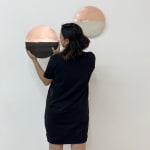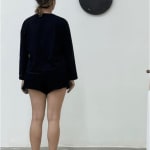Open a larger version of the following image in a popup:
 Installation view: Looking North, Yi Gallery, New York 2023
Installation view: Looking North, Yi Gallery, New York 2023
 Installation view: Looking North, Yi Gallery, New York 2023
Installation view: Looking North, Yi Gallery, New York 2023
Open a larger version of the following image in a popup:
 Installation view: Looking North, Yi Gallery, New York 2023
Installation view: Looking North, Yi Gallery, New York 2023
 Installation view: Looking North, Yi Gallery, New York 2023
Installation view: Looking North, Yi Gallery, New York 2023
Open a larger version of the following image in a popup:
 Installation view: Looking North, Yi Gallery, New York 2023
Installation view: Looking North, Yi Gallery, New York 2023
 Installation view: Looking North, Yi Gallery, New York 2023
Installation view: Looking North, Yi Gallery, New York 2023
Karian Amaya
Alba (Dawn), 2023
Copper and marble
12 x 12 x 1 in
30 x 30 x 3 cm
30 x 30 x 3 cm
Edition of 8
KA0005
Copyright The Artist
Further images
-
(View a larger image of thumbnail 1
)

-
(View a larger image of thumbnail 2
)

-
(View a larger image of thumbnail 3
)

-
(View a larger image of thumbnail 4
)

-
(View a larger image of thumbnail 5
)

-
(View a larger image of thumbnail 6
)

-
(View a larger image of thumbnail 7
)

-
(View a larger image of thumbnail 8
)

-
(View a larger image of thumbnail 9
)

The sculptural form is an abstraction of 'alba'. Alba, or dawn in English, is a transient period that marks the beginning of twilight before sunrise. It begins with the first...
The sculptural form is an abstraction of 'alba'. Alba, or dawn in English, is a transient period that marks the beginning of twilight before sunrise. It begins with the first sight of lightness on the horizon when the moon is hidden, and continues until the sun breaks the horizon. Simultaneously evoking the rising sun and setting moon, 'alba' reflects on the ecological changes that occur after minerals are extracted from their natural environment. Through an eco-sculptural lens, Amaya uses primarily copper and found marble fragments to explore the delicate condition of matter.
Karian Amaya (b.1986, Chihuahua, Mexico) currently lives and works in Guadalajara. The artist traces the origin of her deeply personal and quietly political work to her formative years in northern Mexico. At the heart of Amaya's practice, which spans drawing, photography and sculpture, is a profound concern for process and materials, with each series seeking a formal solution. Informed by minimalism, she explores issues related to language and the deterioration of the landscape. Karian Amaya holds a B.A. from the University of Guadalajara and studied mixed media at The Art Students League of New York. Her work has been exhibited in Mexico, the United States and Europe. In 2015, she participated in the New York Foundation for the Arts migrant artist mentoring program. In 2016, she was included in the Border Biennial at El Paso Museum of Art. Amaya has received numerous awards, including Stimuli for artistic creation PECDA (2013-2014), the Alfaro Siqueiros Scholarship (2017), the Grodman Legacy Scholarship, awarded by the UDG Foundation (2018), Proyecta traslados (2019), Contigo a la Distancia FONCA (2020), the HORIZONTES Jalisco Program (2020), State Council for Culture and the Arts CECA (2021-2022) and Stimulus for artistic creation PECDA CHIHUAHUA 2023 in the category of sculpture.
Karian Amaya’s practice revolves around the notion of encounter. Through sculpture and photography, Amaya investigates and questions the dialogue and resistance originating from matter, landscape and their social and territorial contexts. Deeply influenced by Land art and postminimalist movements, her work is rooted in the formal and narrative encounter of raw, natural and industrial materials. Originally from Chihuahua, Mexico, and daughter of a mining father, Amaya’s work reveals a direct reference to the extractivism of natural materials and the fragility of the landscape affected by human activity and the passage of time. Informed by her intimate relationship with the desert landscape and materials mined in Mexico, such as copper and marble, her sculptures become an abstraction of sunset, where the materials used to be, as a contemplative homage to the organic forms, the silence and the fragility of rocks in pressure and the omnipotent landscape of the desert. Amaya’s work reflects on the deterioration of landscape as a consequence of the exploitation of natural resources and the fluency of time manifested in this process. Interested in their materiality, the poetics they contain from their formation on earth and the processes that contain transformation for industrialization, Amaya explores the circumstances surrounding materials, such as copper and marble: “I usually work with fragments that were found or rescued from their end process, because they were destined to become waste of an aggressive industrialization of the land. My intrinsic narrative allows me to develop new meanings, trying to find beauty within the imperfect, flawed or unfinished, keeping the roots of their own place.”
Karian Amaya (b.1986, Chihuahua, Mexico) currently lives and works in Guadalajara. The artist traces the origin of her deeply personal and quietly political work to her formative years in northern Mexico. At the heart of Amaya's practice, which spans drawing, photography and sculpture, is a profound concern for process and materials, with each series seeking a formal solution. Informed by minimalism, she explores issues related to language and the deterioration of the landscape. Karian Amaya holds a B.A. from the University of Guadalajara and studied mixed media at The Art Students League of New York. Her work has been exhibited in Mexico, the United States and Europe. In 2015, she participated in the New York Foundation for the Arts migrant artist mentoring program. In 2016, she was included in the Border Biennial at El Paso Museum of Art. Amaya has received numerous awards, including Stimuli for artistic creation PECDA (2013-2014), the Alfaro Siqueiros Scholarship (2017), the Grodman Legacy Scholarship, awarded by the UDG Foundation (2018), Proyecta traslados (2019), Contigo a la Distancia FONCA (2020), the HORIZONTES Jalisco Program (2020), State Council for Culture and the Arts CECA (2021-2022) and Stimulus for artistic creation PECDA CHIHUAHUA 2023 in the category of sculpture.
Karian Amaya’s practice revolves around the notion of encounter. Through sculpture and photography, Amaya investigates and questions the dialogue and resistance originating from matter, landscape and their social and territorial contexts. Deeply influenced by Land art and postminimalist movements, her work is rooted in the formal and narrative encounter of raw, natural and industrial materials. Originally from Chihuahua, Mexico, and daughter of a mining father, Amaya’s work reveals a direct reference to the extractivism of natural materials and the fragility of the landscape affected by human activity and the passage of time. Informed by her intimate relationship with the desert landscape and materials mined in Mexico, such as copper and marble, her sculptures become an abstraction of sunset, where the materials used to be, as a contemplative homage to the organic forms, the silence and the fragility of rocks in pressure and the omnipotent landscape of the desert. Amaya’s work reflects on the deterioration of landscape as a consequence of the exploitation of natural resources and the fluency of time manifested in this process. Interested in their materiality, the poetics they contain from their formation on earth and the processes that contain transformation for industrialization, Amaya explores the circumstances surrounding materials, such as copper and marble: “I usually work with fragments that were found or rescued from their end process, because they were destined to become waste of an aggressive industrialization of the land. My intrinsic narrative allows me to develop new meanings, trying to find beauty within the imperfect, flawed or unfinished, keeping the roots of their own place.”





